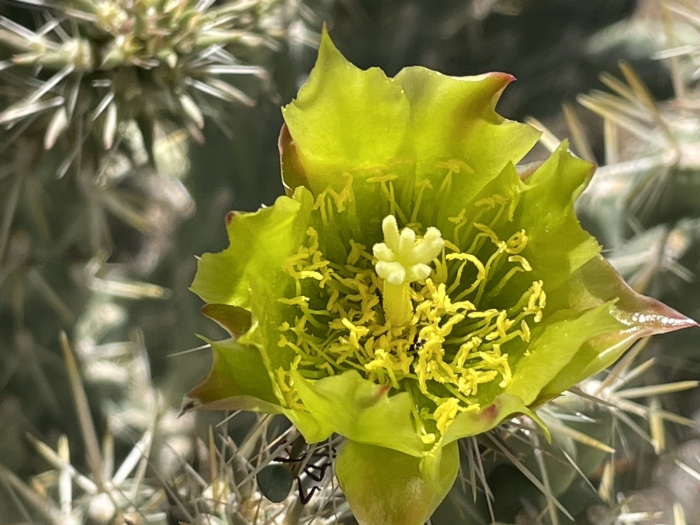Snake Cholla
(Cylindropuntia californica)
Snake Cholla (Cylindropuntia californica)
/
/

Bobby McCabe
CC BY 4.0
Image By:
Bobby McCabe
Recorded By:
Copyright:
CC BY 4.0
Copyright Notice:
Photo by: Bobby McCabe | License Type: CC BY 4.0 | License URL: http://creativecommons.org/licenses/by/4.0/ | Rights Holder: Bobby McCabe | Publisher: iNaturalist | Date Created: 2022-06-27T00:33:31Z |
























Estimated Native Range
Summary
Cylindropuntia californica, commonly known as snake cholla, is a perennial cactus native to the coastal sage scrub and chaparral of Baja California, Mexico, and part of California, including some desert regions. It is a short, sprawling cactus that typically grows less than 5 feet in height, with multiple trunks and elongated, segmented stems. The stems are covered in spines, which are characteristic of the Cylindropuntia genus. Snake cholla blooms with yellow to yellow-green flowers, followed by leathery fruit, although the plant is not primarily grown for its flowers. The blooming period occurs in the late spring to early summer.
Snake cholla is valued for its unique form and texture in xeriscapes and rock gardens, where it contributes to a desert or southwestern aesthetic. It is drought-tolerant and requires minimal maintenance once established, making it suitable for low-water-use landscapes. This cactus prefers full sun and well-draining soil, and it is capable of withstanding high temperatures and direct sunlight. It is rarely used in large-scale plantings due to its spiny nature but can serve as an accent plant in appropriate settings. In cultivation, it is important to avoid overwatering to prevent root rot. The variety californica is considered rare and threatened in California, with a California Native Plant Society listing of 1B.1, indicating that it is seriously threatened in its native habitat.CC BY-SA 4.0
Snake cholla is valued for its unique form and texture in xeriscapes and rock gardens, where it contributes to a desert or southwestern aesthetic. It is drought-tolerant and requires minimal maintenance once established, making it suitable for low-water-use landscapes. This cactus prefers full sun and well-draining soil, and it is capable of withstanding high temperatures and direct sunlight. It is rarely used in large-scale plantings due to its spiny nature but can serve as an accent plant in appropriate settings. In cultivation, it is important to avoid overwatering to prevent root rot. The variety californica is considered rare and threatened in California, with a California Native Plant Society listing of 1B.1, indicating that it is seriously threatened in its native habitat.CC BY-SA 4.0
Plant Description
- Plant Type: Succulent
- Height: 2-6 feet
- Width: 1.5-3 feet
- Growth Rate: Moderate
- Flower Color: Green, Red, Yellow
- Flowering Season: Spring, Summer
- Leaf Retention: Evergreen
Growth Requirements
- Sun: Full Sun
- Water: Low, Medium
- Drainage: Fast, Medium
Common Uses
Border Plant, Drought Tolerant, Fire Resistant, Low Maintenance, Rock Garden, Showy Flowers
Natural Habitat
native to the coastal sage scrub and chaparral of Baja California, Mexico, and part of California, including some desert regions
Other Names
Common Names: Cane Cholla, California Cholla
Scientific Names: , Cylindropuntia californica, Cylindropuntia californica var. californica, Opuntia californica var. californica,
GBIF Accepted Name: